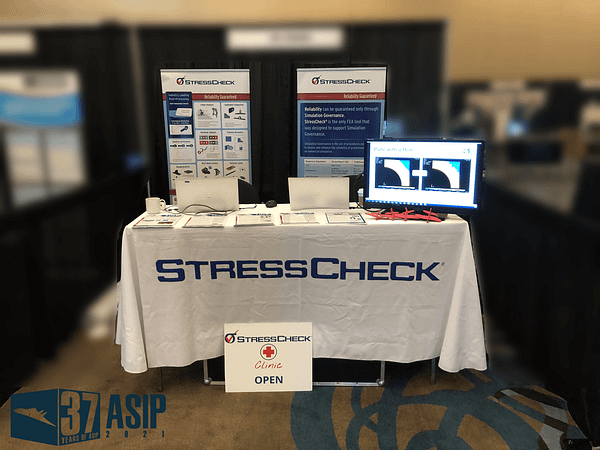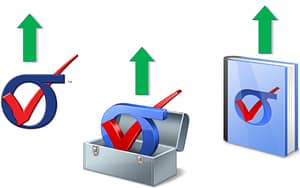
While this past year continued to present unique challenges and unprecedented disturbances, we hope that you found our customer support, on-demand webinars, web-based training services and overall experience with our team to be refreshingly positive. It is our pleasure to serve you, and we look forward to what the next year brings!
The following are a few highlights we’d like to share:
ASIP Conference 2021 Impressions…

In late November 2021, ESRD exhibited at the ASIP Conference and had a blast re-connecting with StressCheck users, DaDT colleagues and our partners Hill Engineering (BAMpF 3D fatigue crack growth software developers) and LexTech (AFGROW developers). We also provided a training course on standardization and automation of DaDT solutions via StressCheck-based Sim Apps.
Read more about our conference proceedings here.
New Edition of Wiley’s Finite Element Analysis Released…

In June 2021, Wiley published the second edition of “Finite Element Analysis: Method, Verification and Validation” by ESRD Co-Founders Dr. Barna Szabo and Dr. Ivo Babuška as part of their “Wiley Series in Computational Mechanics“. This edition provides an updated and comprehensive review of the theoretical foundation of the finite element method, and provides engineering students and professionals the tools, concepts, techniques, and procedures that help with an understanding of finite element analysis.
For more information on the new edition, click here.
Live Web-Based Training Options Expanded…
With engineers continuing to work mostly from home or in limited-capacity office settings, we expanded and refined our web-based StressCheck training options to provide more clarity on our supported DaDT features. In addition to revising our successful web-based Intro to StressCheck course, we also developed and deployed a web-based version of our Advanced Training in Fracture Mechanics course. This advanced StressCheck training course focuses on DaDT applications for which StressCheck is well-suited, as well as modeling, analysis and extraction best practices for 2D and 3D crack modeling.
Even though we could not be face-to-face, it was a pleasure connecting with our users via webcam/audio and helping them achieve proficiency with StressCheck’s features.
For more information on scheduling a live web-based training, click here.
Enhanced DaDT Analysis Features In Development…

Since the release of StressCheck v11 Update 1 in June 2021, we have been hard at work in preparing for the release of StressCheck v11.1. With this forthcoming release (expected in mid-2022), we are focusing on significant improvements to 3D crack front automeshes and SIF extractions (mixed tetra/penta/hexa meshes are now supported!!) as well as scaling features for imported global loads (TLAPs can now be scaled via parameters in linear or nonlinear analysis!!).
Live Webinar Coming Soon
In Q1 2022, we are planning for a live webinar to preview StressCheck’s new DaDT and TLAP scaling enhancements, and answer questions about the upcoming release of StressCheck v11.1.
Pre-register for the “New and Improved Features for 3D Fracture Mechanics Analysis in StressCheck” webinar:
Once a date/time is announced, you will be notified with more details about the webinar. Stay tuned!
Preview: Mixed Boundary Layer Automesh and SIF Extraction Improvements
The following is a brief demo of the mixed boundary layer automeshing feature (with SIF comparisons) coming soon in StressCheck v11.1:
- 0:00-1:20 mark – Two all-tetrahedral element boundary layers are automeshed around the crack front of a 180 degree embedded ellipse using the original Crack Front method available in v11.0.
- The model is then solved at p=4 (for demonstration purposes) and the SIF distribution along the crack front is extracted using Radius = AUTO.
- 1:21-2:44 mark – Four pentahedral/hexahedral element boundary layers are automeshed around the crack front of a 180 degree embedded ellipse using the new Crack Front method available in v11.1 (and StressCheck v11 Update 1 for beta testing).
- The model is re-solved solved at p=4 (for demonstration purposes) and the SIF distribution along the crack front is re-extracted using Radius = AUTO.
- 2:45-3:43 mark – The two SIF distributions are compared, with the new Crack Front automeshing method demonstrating clear improvements in efficiency and quality.
Wishing for Good Tidings and Good Health

Finally, we’d like to wish all of our customers, partners and friends Happy/Safe Holidays and a Happier/Healthier 2022!
Keep up with the latest from ESRD by subscribing to our newsletter:
 Serving the Numerical Simulation community since 1989
Serving the Numerical Simulation community since 1989 










Leave a Reply
We appreciate your feedback!
You must be logged in to post a comment.